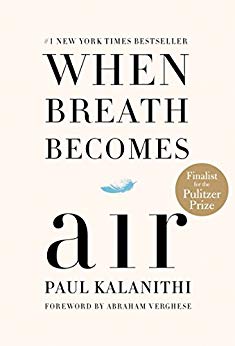

This article is an excerpt from the Shortform summary of "When Breath Becomes Air" by Dr. Paul Kalanithi. Shortform has the world's best summaries of books you should be reading.
Like this article? Sign up for a free trial here .
Paul Kalanithi studied both biology and literature, and felt deeply that language was the path to connectivity.
Paul’s specific approach to the doctor-patient relationship was one where he tried to understand the person as a whole, and their identity. He called this method human relationality. He applied human relationality as a doctor, and experienced it as a patient with Dr. Emma Hayward. Below, Paul explains how he came back to his view on the doctor-patient relationship after years of overlooking it in favor of statistics and numbers, and how holding onto this philosophy later helped him as a patient.
Shortform note: This article and our summary of When Breath Becomes Air is written in a way that allows you to share in the experience provided by the memoir.
Simply reading about the content of the story seems insufficient in expressing the emotional journey. To really provide you with the sensation this book creates, we wrote in the first person, using a voice similar to his. We highly recommend reading the original book for the full experience. Reading the words coming directly from him is a powerful experience we can’t replace.
Language and Medicine in Doctor-Patient Relationships
I believed that language created our sense of significance and integrity. Language created bonds between people. From these ideas, I came to understand that human relationally was what engendered meaning. I started to consider that the brain was not solely representative of this process. The whole body was inextricably involved somehow.
A car accident now conjured all the pictures I had in my head of procedures, processes, and possible injuries that would lead to death. I had all the information I needed as a doctor to understand Laurie’s death. I understood it as I would any other patient.
This brought me to the doctor-patient relationship. Each moment that I had failed to recognize the patients I saw as people, as priorities, as suffering individuals worthy of empathy and focused care, flooded my mind. I had moved through patients’ pain, worries, and diagnoses like a worker on a factory line. I felt crushing guilt. I had failed to recognize the significance of the situation and their lives. I was turning into Tolstoy’s cliche of a doctor: mechanically treating disease without noticing the individual.
Human relationality was once of great importance to me, but I had forgotten it amid the harried world of diagnosis and prognosis. It wasn’t sufficient to just be an excellent surgeon. I had to be an excellent physician, which meant guiding those in my care, including families, to a place where tragedy can be comprehended, and forming a compassionate doctor-patient relationship, or physician patient relationship.
This role, the pastoral one, became my highest priority, for often the families are equally blinded to delicate facets of life and death. They look at their sick or injured loved one and see the person they were, the life they lived, and the memories they shared. It was a sight of the past, whereas I understood the realities of the future.
I could use this knowledge to help these families understand that, with severe brain trauma, the body in front of them no longer contained that image from the past. The questions were all about the future: whether their loved one could have one and whether they should. Because only the family knows for certain if a dramatically altered quality of life would be worth it, or whether death would be preferred. It was their decision, and I wanted to serve as an usher to help them make it, a part of the doctor-patient relationship or physician patient relationship that is easy to overlook in a busy day.
Human relationality requires honesty, but honesty doesn’t mean overwhelming patients with a giant bolus of mortality. It is not uncommon for patients and families to tune out and lose their tongues after receiving bad news. At these moments, all there is to do is take their hand and guide them as far as they can go until they’re ready for more. Families are a part of the doctor and patient relationship.
Yet, making the doctor-patient relationship a priority was difficult, and doing so had consequences. Meeting patients in the foggy space between the past and future was emotionally taxing. I didn’t realize how much so until I was driving home one night in my third year and realized I was crying. But still, I never questioned the work or the value in it. The call to be a neurosurgeon—as it is a calling—is a virtuous endeavor, not simply because of the lives we are able to save, but because of the identities we are tasked to maintain.
Before any surgical procedure was performed, I needed to get a sense of that person’s identity as a part of the doctor-patient relationship. I needed to know their mind, what they valued, what they lived for, what they could live without, and what they couldn’t. Taking on that burden is a costly venture, for success in surgery is not guaranteed. And in those moments, the ones where we fail, the guilt is immeasurable.
How Human Relationality Helped Paul Kalinithi
I didn’t know who I was out in the world. I wasn’t a neurosurgeon I wasn’t a fit and capable man at the beginning of life. I wasn’t the husband my wife deserved. I had once been someone who could lead and make things happen. Now, I was someone who followed, a recipient rather than agent. (Shortform note: Paul is referring to the time following his diagnosis, when he stopped working as a doctor)
The only time I had any sense of being myself was when I was in Emma’s office, though I was on the other end of the doctor and patient relationship.
Emma challenged me to concentrate on his values and priorities, rather than his chances. These thoughts included those of being a father, and Lucy and I revisited their thoughts on having a child. We both felt that if human relationality was the foundation of a meaningful life, a child could only enhance that. Lucy was concerned about whether raising a child was the right choice for me for whatever time he had left. I was concerned about whether raising a child alone and simultaneously caring for a sick husband was the right choice for her life. But Lucy and I chose to start a family, and enrich our lives.
Shortform note: Paul Kalanithi’s focus on human relationality in his doctor-patient relationships led him to be able to see the whole picture in his own diagnosis and treatment. Paul’s approach meant seeing the patient for their identity, and treating a person. Though he was on the side of the doctor and patient relationship that he never expected, he was able to use human relationality to find compassion for himself and begin to dictate the terms of his life.

———End of Preview———
Like what you just read? Read the rest of the world's best summary of Dr. Paul Kalanithi's "When Breath Becomes Air" at Shortform .
Here's what you'll find in our full When Breath Becomes Air summary :
- How Paul Kalanithi discovered he had cancer
- How Paul coped with his cancer until his very end
- How Paul's wife dealt with his death and found the strength to continue






